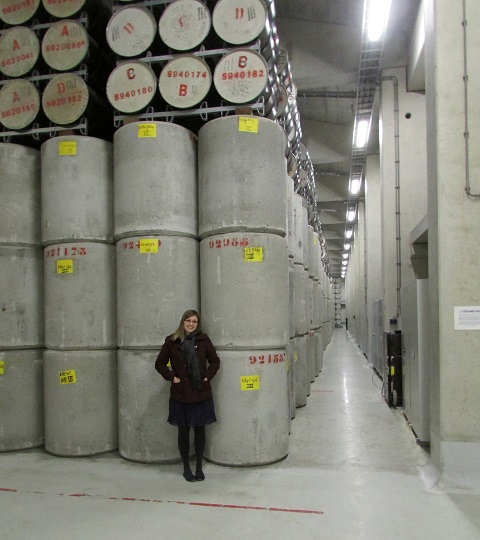Marriage and Nuclear Waste Management
What marriage can teach us about the nuclear waste problem
I am married to an engineer. My husband, Ted, is amazingly brilliant and always has big new projects happening, both at work and at home. At work he is figuring out how to improve hybrid vehicle batteries to reduce automobile emissions. At home he's built our dining table, a shed, a chicken coop, raised garden beds, fences, rock walls, a walking path, a pizza oven, a shooting range, and a fully automated home beer brewing robot. He gardens, he cooks, he digs trenches. I know! I'm a very lucky girl!
Because I love the outcomes of all of these great projects, a significant portion of my home life is spent chasing him around like a crazy person helping to clean up messes. But it works. We are a great team. I try to set him up for success by making sure the messes of past projects are dealt with effectively before he starts on the next thing. How can you build a porch if you don't know where your drill bits are? And in turn he always checks in with me about which projects to prioritize and how to best manage our resources. We rarely make a decision about any project without a spreadsheet and a Solid Works drawing first.
Messes and priorities
The nuclear industry is currently a bit like Ted before Suzy. Tons of amazing ideas and all of the necessary skills to create them-but a big problem with managing past messes, and some issues with setting priorities. As a nontechnical person, I don't tend to make recommendations for specific technologies, but in a recent conversation (which reminded me of any given Tuesday at the Baker house), I laid out my thoughts on how to best manage our commercial nuclear waste. It struck me that these thoughts may be worth sharing.
The conversation started in a Google group after someone posted an article I wrote about CORVA-the nuclear waste storage facility in the Netherlands-as a part of the Nuclear Tourist series. In the post I asserted that, "Nuclear waste storage is perhaps the one thing that nuclear supporters, opponents, nonproliferation experts, politicians and everyday folks all agree on!!" As a proponent of interest bargaining, I see the waste issue as a key platform for building trust and collaboration in the near term, and enabling growth in the long term. I knew when I wrote that statement that I was going to get some backlash from nuclear supporters about how [insert your favorite generation IV reactor here] is going to make a repository unnecessary.
So, here's the deal. Much like at my house, where a new project doesn't get started until the last one has been finished-finishing what you've started is a huge part of building trust and responsibly managing resources. In addition, even with advanced reactor technologies, there is going to be some waste-from reprocessing, from research reactors, medicine, and industry. Of course, it would not make sense to put valuable usable materials into a geologic repository-but that doesn't mean we shouldn't have one for true waste. In fact, if done properly, putting this infrastructure into place will strengthen public trust and show that we are responsible and ready to move forward with advanced technologies.
Moving forward with America's nuclear waste
So as someone who is quite experienced, not in actual nuclear engineering, but in wrangling an engineer (namely, my hubs) and helping to maximize the benefits of his ideas-here are my thoughts on how to best move forward with America's nuclear waste (which has been slightly edited/ improved upon for this post):
In my dream scenario, we finish the Mixed Oxide Fuel (MOX) facility at the Savannah River Site in South Carolina, start reprocessing and build an interim facility somewhere on the east coast using the Blue Ribbon Commission on America's Nuclear Future recommendations of community-based siting. Then get policy in place to open the Waste Isolation Pilot Project (WIPP), in New Mexico, up to commercial waste, possibly even building an above-ground interim facility there as well to serve the West Coast. Then we only place materials that absolutely are waste into the salt bed at WIPP-medical, industrial and research waste, vitrified waste from reprocessing-keeping potentially useful materials at the interim sites for future advanced reactors.

The author at the COVRA interim waste storage facility. If they can figure this out in the Netherlands, we can do it here too.
This scenario takes into consideration upholding important international nonproliferation agreements with Russia, and continues the legacy established by the Megatons to Megawatts program of dismantling weapons and using the materials to produce low-carbon domestic energy. Then no one can say that we don't know what to do with the waste, that we are unreliable partners, that we aren't taking proper steps to prevent proliferation-the standard criticisms used to derail many a nuclear project.
And in terms of transport-there are over 54,000 shipments of radioactive materials EACH DAY worldwide. Increasing US transport would barely impact the existing number. The French ship spent fuel in from all over Europe and Asia-much further distances than anything in the United State. Again-this is not a technical problem-but rather a political one. But unless we learn to solve the political problems, we will never get the technical solutions implemented.
I also think that the federal government-which is responsible for a whole lot of the fear and distrust associated with nuclear waste due to mismanagement of legacy materials and the failure to complete the Yucca Mountain repository-needs to be accountable and prioritize solving the nuclear waste issue as a matter of national security on multiple fronts: domestic energy security, nonproliferation, and climate change. These are pressing issues for every American. Functioning waste management infrastructure is essential to solving multiple extremely important challenges.
Next: La Hague reprocessing facility
Next week I travel to France to tour the La Hague reprocessing facility and will undoubtedly learn a great deal and probably have a lot more information to add to my "dream scenario"-perhaps I will even have a whole new perspective on the situation. But one thing I know for sure from traveling throughout Europe for the past three months is that we have a lot of excellent options in managing nuclear waste, and that this problem is solvable. We just have to focus on the cultural and political challenges, like accountability, perceptions, and trust, as much as we focus on the technical challenges. Striking that balance is critical in achieving positive outcomes (pardon the pun).
Full disclosure: AREVA, one of the companies involved in building the MOX facility in the United States, is one of the sponsors for the Nuclear Tourist project. As a resident of South Carolina, I have been an active proponent of the MOX facility well before their sponsorship, even helping to organize a rally at a public meeting last year. Opinions expressed here are my own and do not necessarily reflect those of sponsors of the Nuclear Literacy Project or PopAtomic Studios.
_______________________________
 Suzy Baker is currently traveling through Europe and reporting on her experiences at Diary of a Nuclear Tourist-a new initiative of the Nuclear Literacy Project. Keep up with her nuclear adventures and be sure to check out the new photo stream. If you have questions for nuclear industry leaders, write them on an index card, then scan or photograph and email to Suzy@nuclearliteracy.org
Suzy Baker is currently traveling through Europe and reporting on her experiences at Diary of a Nuclear Tourist-a new initiative of the Nuclear Literacy Project. Keep up with her nuclear adventures and be sure to check out the new photo stream. If you have questions for nuclear industry leaders, write them on an index card, then scan or photograph and email to Suzy@nuclearliteracy.org


